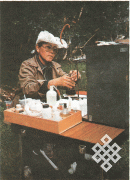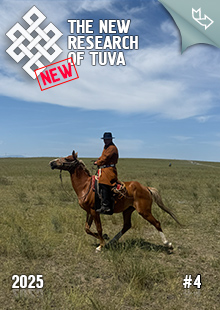 Our republic is rich in natural water therapy (balneology) resources. To date, more than 100 water springs and water bodies have been identified, that have some degree of therapeutic properties. Every year several tens of thousands of people undergo therapy at our arzhaans. The phenomenon of "arzhaan therapy", which has been a fundamental component of the culture and tradition of Tuvan nation since the most ancient times, is a unique phenomenon preserved on a large scale only in Tuva among SNG countries and Russia.
Our republic is rich in natural water therapy (balneology) resources. To date, more than 100 water springs and water bodies have been identified, that have some degree of therapeutic properties. Every year several tens of thousands of people undergo therapy at our arzhaans. The phenomenon of "arzhaan therapy", which has been a fundamental component of the culture and tradition of Tuvan nation since the most ancient times, is a unique phenomenon preserved on a large scale only in Tuva among SNG countries and Russia.
On the eve of the official start of the next mass season of therapy at the arzhaans, we decided to talk with one of the few researchers who specialize in the study of hydromineral resources of Tuva, candidate of chemistry, K. D. Arakchaa. Currently she is the head of an enterprise acting under the auspices of TuvGU, and together with other scientists of our university she is performing studies of therapeutic properties of Tuvan healing springs.
- Kara-Kys Dongakovna, you began to study arzhaans already in the '80's, and now you are continuing this work under the aegis of Tuvan university. To what extent has this subject been studied?
- Research of hydromineral resources of Tuva has been conducted by many scientists. We can name V. M. Levchenko (at the time of TNR), A.O. Blumenfeld ('50's), E. V. Pinneker ('60's) and others. This research was basically devoted to the study of macro-chemical indices of hydromineral resources of Tuva. By now, more than 50 expressions of mineral therapeutic waters have been investigated and registered, including 37 groups of mineral arzhaans and 13 salt and mud lakes.
As far as the contribution of Tuvan scientists is concerned, since the end of '80's, I and K. S. Kuzhuget, together with scientists from Irkutsk State University 9G. M. Shleiser and others) and from Tomsk polytechnic university ( now deceased M. B. Bukaty and others), have performed complex investigations of hydromineral resources of Tuva. These investigations have involved practically the entire territory of the republic. Hydrochemical, geophysical, microbiological, ecological, radon- and heliometric investigations were performed. More than 70 mineral and freshwater arzhaans have been studied on 50 different indices.
Currently the work on studying the arzhaans continues in the framework of research programs of TuvGU. It would be difficult to overestimate the help the university shows to the study of this subject. First, it is one of the founders of OOO "Laboratory of arzhaanology and tourism"; I am the head of it. Second, it supplied a legal address and permitted the use of their premises and scientific equipment at Scientific-educational center for collective use. And the equipment there is serious. Just the universal fluid chromatography "Milikhrom A-02" costs almost one-and-a-half million rubles.
Scientific research of healing waters is now being carried out by a group of scientists at the chemistry department of EGF TuvGU. Chiefly it aims at the identification of possible therapeutic factors and healing properties of Tuvan arzhaans. The research is carried out according to a thematic scientific plan of the university, which is financed from the federal budget through Ministry of Education of Russian Federation. Scientific-Educational Center of collective use of TuvGU also won a regional grant of RFFI. These means will also be directed towards investigations of arzhaans.
- What tasks have you set for this summer season?
- We would like to continue the work investigating the healing properties of the natural arzhaan complex "Choigan mineral waters" together with Tomsk NII of balneology and physiotherapy. We are planning parallel development of tourist trails to arzhaan Choigan.
- Many arzhaans that are popular among the people are fresh-water ones. What is their therapeutic effectiveness?
- That is one of the core problems of our investigations. It is because in contrast to the mineral springs and lakes, the therapeutic effect of fresh-water arzhaans has not been studied and proved so far. On the other hand, we see the immense popularity of many fresh-water arzhaans among the people, and associated legends about the magical healing properties of their waters.
Our latest research has allowed us to formulate the tasks for the study of the phenomenon of "arzhaan therapy' in fresh and ultra-fresh springs, with consideration of facts of healing of some diseases at various fresh-water arzhaans of Tuva.
- Will you search for the reasons for the healing properties of the fresh-water arzhaans that scientists were not able to establish before? Approximately what directions of such search are possible?
- There can be several directions. It is necessary to pay attention to scientific achievements in the study of the structure and properties of water, including that subjected to magnetism, literature in the subject of magnetic therapy, results of research of influence of geomagnetic fields on living organisms, influence of trace amounts of substances, including microelements, on metabolic processes in living organisms at the cellular level, etc. All this will make it possible to formulate the tasks of further investigations of fresh-water arzhaans, and, correspondingly, it will help to elucidate the unique properties of the waters of natural springs at the moment when they surface.
At the same time the scope of the investigations of fresh- and ultra-fresh arzhaans practically all over the territory of the republic makes it possible to perform comparative analysis of the data obtained with the use of research methods of natural sciences (physics, chemistry, hydrogeology, geochemistry) as well as with the data of use of arzhaans with therapeutic intent by local population. This way one can obtain statistically significant results.
Study of the micro-component composition of fresh-water arzhaans is also important, for example that even trace amounts of silver ions in the waters determine their bactericidal properties. The forms of the microelements in natural waters can also be the cause of therapeutic effect of fresh-water arzhaans.
For example, investigation of the content of micro- and macro-component composition of fresh-water arzhaan Uurgailyg and their separation by fractions showed that, first, the elements contained in the arzhaan water are bound in macromolecular structures. And second, the time period and the conditions of how the arzhaan water samples are kept substantially affect the forms of the elements - separation of the elements by fractions takes place. Could that be the reason for the apparent mysterious loss of healing properties of fresh-water arzhaans if they are kept for a long time?
Systematic investigations also have to be performed regarding organic substances in fresh-water arzhaans, for example the content of volatile phenols in certain amounts may also determine their bactericidal properties.
There is another direction which attracts our attention - the possibility of positive effect of weak radioactive radiation of natural waters, equivalent to radioactive balance of human organism. An analogous effect of microinclusions of radionuclides in minerals was discovered by candidate of biological sciences E. N. Badigina, and used in carnelian therapy.
- How would one postulate the mechanism of therapeutic effect on human organism?
- Two mechanisms are being looked at in contemporary balneology - pharmacological and reflexive. The reflexive theory explains the direction of the movement of the reflex: skin, nerve receptors, acupuncture points, nerve fibers, nervous system, internal organs. The working hypothesis is that the true mechanism of therapeutic action of physical factor on an organism of the patient is the bioenergetic resonance between the intrinsic electric energy of the physical factor and the intrinsic electric energy of intracellular elements of the tissues and organs.
 From this position it is possible to explain the therapeutic effect of fresh- and ultra-fresh water arzhaans that do not contain biologically active components in balneologic quantities.
From this position it is possible to explain the therapeutic effect of fresh- and ultra-fresh water arzhaans that do not contain biologically active components in balneologic quantities.
- This tradition also has its vivid ethnographic aspect. After all, arzhaan cures have ancient roots, and unique rituals, customs, and examples of oral folk art are associated with it, not even mentioning the rules for taking arzhaan water.
- I agree with you. Beside the investigation of composition of the waters, it is also necessary to study arzhaan therapy as an ancient tradition of Tuvan people. Considering also that the use of this or that natural therapeutic factor always reflects the world-view of the people who live in a certain climatic-geographic region.
- What do you think - if we regard arzhaan therapy as a purely Tuvan phenomenon, can it be preserved in the conditions of increasing interest from elsewhere?
- I don't think that it is a problem. On the contrary, we should use our experience of utilization of arzhaans to attract tourism. We already have some experience of practical utilization of natural water therapeutic resources. Since the middle of last century, spas have been active on lake Cheder, at Ush-Beldir hot sulphur springs (Northern arzhaan), organized therapy during soviet times was also present at Tarys sulphur hot springs (Southern arzhaan). There are active sanatoriums at lake Dus-Khol and arzhaan Shivilig.
Currently private enterprise has been notably active in organization and infrastructure for relaxation and so far unstructured therapy at some Tuvan arzhaans, for example arzhaans Senek, (Ulug-Khem), Ak-Khaiyrakan (Erzin), Ala-Taiga (Mongun-Taiga) and others.
A wide spectrum of natural water therapy resources, wide spread phenomenon of "arzhaan cures" in the republic, the fame of many arzhaans, salt and mud lakes outside of the republic allow us to consider the development of tourist-recreational special economic zones at natural arzhaan complexes a promising prospect. Such zones could be established later also in Bai-Taiga and Mongun-taiga kozhuuns, in the east - in Todzha and Tere-Khol, and in the south - in Ovyur and Erzin kozhuuns.
Organization of across-border and interregional touristic reciprocity is also possible - at Tarys complex of mineral waters, Choigan arzhaan (Todzha), Ulaatai spring of radon waters (Ovyur), arzhaan complex Khuregechi (Chedi-Khol), as well as fresh-water arzhaan complexes Ak-Khaiyrakan (Erzin), Uurgailyg and Mannailyg (Tandy), Ala-Taiga and Aspaty (Mongun-Taiga), and Taldyg-Charyk and Aksy-Durug (Ovyur).

